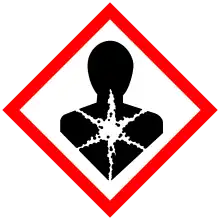Nickel tungstate
Nickel tungstate is an inorganic compound of nickel, tungsten and oxygen, with the chemical formula of NiWO4.
 | |
| Names | |
|---|---|
| Other names
Nickel(II) tungstate Nickel tungsten oxide | |
| Identifiers | |
3D model (JSmol) |
|
| ChemSpider | |
| ECHA InfoCard | 100.034.560 |
| EC Number |
|
PubChem CID |
|
CompTox Dashboard (EPA) |
|
| |
| |
| Properties | |
| NiWO4 | |
| Molar mass | 306.534 |
| Appearance | green crystals[1] |
| Odor | odourless[1][2] |
| Density | 3.3723 g/cm³[3] |
| Melting point | 1420 ˚C[4] |
| 465,2 mg/100 mL (20 ˚C) | |
| Solubility | soluble in ammonia |
| Structure | |
| monoclinic crystal system | |
| Hazards | |
| GHS labelling: | |
  | |
| Danger | |
| H317, H350i, H372 | |
| P201, P260, P280, P308+P313, P405, P501 | |
| Related compounds | |
Other anions |
Nickel(II) chromate Nickel(II) molybdate |
Other cations |
Iron(II) tungstate Cobalt(II) tungstate Zinc(II) tungstate |
Except where otherwise noted, data are given for materials in their standard state (at 25 °C [77 °F], 100 kPa).
Infobox references | |
Preparation
Nickel tungstate can be prepared by the reaction of nickel(II) nitrate and sodium tungstate:[5]
- Ni(NO3)2 + Na2WO4 → NiWO4 + 2 NaNO3
Nickel tungstate can also be prepared by the reaction of nickel(II) oxide and tungsten(VI) oxide.[6]
It can also be obtained by the reaction of ammonium metatungstate and nickel(II) nitrate[7] or from the reaction of sodium tungstate, nickel(II) chloride and sodium chloride.[8]
Nickel tungstate undergoes a phase transition at 700°C.[5]
Properties
Nickel tungstate is a light brown, odourless solid that is insoluble in water.[2] The amorphous form is green and the polycrystalline form is brown.[5] It crystallizes in the wolframite crystal structure of the monoclinic crystal system with space group P2/c (No. 13).[9][8] The compound is antiferromagnetic.[10][11]
Applications
Nickel tungstate has no commercial uses. It has been examined as a photocatalyst, in humidity sensors, and in dielectric resonators. It is also considered as a "promising" cathode material for asymmetric supercapacitors.[1][12]
Other compounds
Nickel tungstate forms compounds with ammonia, such as NiWO4·2NH3·H2O which are cyan crystals,[13] NiWO4·4NH3 which are green crystals,[14] NiWO4·5NH3·H2O as dark blue crystals[13] or anhydrous NiWO4·6NH3 which is crystalline purple, while the octahydrate of hexamine is dark blue.[14]
References
- Nickel tungsten oxide, 99.9% (metals basis excluding Co), Co <100ppm at AlfaAesar, accessed on {{{Datum}}} (PDF) (JavaScript required).
- Record of Nickel-Wolframtetraoxid in the GESTIS Substance Database of the Institute for Occupational Safety and Health, accessed on 2020-01-08.
- Hicham Oudghiri-Hassani, Fahd Al Wadaani – Preparation, Characterization and Catalytic Activity of Nickel Molybdate (NiMoO4) Nanoparticles. doi:10.3390/molecules23020273.
- Lebukhova, N. V.; Inorganic Materials, (2006), 42(3), 310-315, CAplus
- A. Kuzmin, J. Purans, R. Kalendarev: Local structure and vibrational dynamics in NiWO4. In: Ferroelectrics. 258, 2001, S. 21, doi:10.1080/00150190108008653.
- Falko P. Netzer, Alessandro Fortunelli (2016), Oxide Materials at the Two-Dimensional Limit (in German), Springer, p. 386, Bibcode:2016omtd.book.....N, ISBN 978-3-319-28332-6
{{citation}}: CS1 maint: date and year (link) - J.M. Quintana-Melgoza, J. Cruz-Reyes, M. Avalos-Borja: Synthesis and characterization of NiWO4 crystals. In: Materials Letters. 47, 2001, S. 314, doi:10.1016/S0167-577X(00)00272-X.
- R. O. Keeling: The structure of NiWO4. In: Acta Crystallographica. 10, S. 209, doi:10.1107/S0365110X57000651.
- Mark Ladd, Rex Palmer (2014), [, p. 277, at Google Books Structure Determination by X-ray Crystallography Analysis by X-rays and Neutrons] (in German), Springer Science & Business Media, p. 277, ISBN 978-1-4614-3954-7
{{citation}}: Check|url=value (help)CS1 maint: date and year (link) - C. Wilkinson, Μ. J. Sprague: The magnetic structures of NiWO4 and CoWO4. In: Zeitschrift für Kristallographie - Crystalline Materials. 145, 1977, doi:10.1524/zkri.1977.145.16.96.
- Alexei Kuzmin, Aleksandr Kalinko, Robert Evarestov: First-principles LCAO study of phonons in NiWO4. In: Open Physics. 9, 2011, doi:10.2478/s11534-010-0091-z.
- R.A. Evarestov (2013), Quantum Chemistry of Solids LCAO Treatment of Crystals and Nanostructures (in German), Springer Science & Business Media, p. 480, ISBN 978-3-642-30356-2
{{citation}}: CS1 maint: date and year (link) - Nickel: sect. 1-2. Coordination compounds with neutral and inner-complex-forming ligands (Verlag Chemie, 1968), page 109. Retrieved 15 Apr 2021.
- Bulletin de la Société chimique de France (Société chimique de France; Masson, 1921), page 1487. Retrieved 28 Feb 2021.